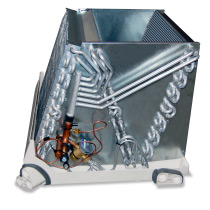Buyer’s Guide
Your friendly companion on the journey to understanding heating, ventilation, and air conditioning systems!

Welcome to our HVAC Buyer’s Guide
Have you heard about the major HVAC scams out there?
If not, you’re going to want to check out our page on it. You might already have a rental agreement for your hot water tank or HVAC system, but did you know that there could be some serious end-of-term costs involved? Don’t get caught off guard! Take a look at our page and make sure you’re not getting taken for a ride.
We’ve created this guide to make things simple and enjoyable for you, breaking down the not-so-fun industry jargon and highlighting the cool tech stuff. Whether you’re a seasoned homeowner or dipping your toes into the HVAC world for the first time, we’re here to make your exploration a breeze. Forget about brand bias – our focus is on what matters most for your comfort. We hope this guide makes you smile while helping you make the best choice for your home’s cozy vibes. No matter the brand, your comfort is our top priority, and we’re excited to be part of your journey to a more comfortable and delightful living space!
A
AFUE
AFUE stands for Annual Fuel Utilization Efficiency. It is a measure of a furnace’s or boiler’s efficiency in converting fuel to energy over a typical year. Specifically, it measures the amount of fuel that is converted to heat compared to the amount lost up the chimney. AFUE is expressed as a percentage, with higher values indicating more efficient use of the fuel. For example, a furnace with an AFUE of 90% converts 90% of the fuel to heat, while 10% is lost.
Air Handler
Air Handler is a central component of an HVAC system and is responsible for the circulation and conditioning of air within a building. Equipped with a blower fan, it draws air through return ducts, passes it overheating or cooling coils, and then distributes the conditioned air back into the living or working spaces through supply ducts. The system often includes air filtration to improve indoor air quality by capturing particles, as well as components for humidity control. Modern air handlers incorporate electronic controls, facilitating precise regulation of temperature, airflow, and overall HVAC integration.
B
Blower Fan
The air handler contains a fan or blower that is responsible for moving air through the system. This fan circulates air from the building through the return ducts, passes it over the heating or cooling elements, and then distributes the conditioned air back into the living spaces through the supply ducts.
BTU
BTU stands for British Thermal Unit, a unit of measurement used to quantify the amount of heat energy. One BTU is equivalent to the amount of energy required to raise the temperature of one pound of water by one degree Fahrenheit. The higher the BTU rating, the greater the heating or cooling capacity of the device, indicating its ability to generate or remove heat. Understanding BTUs is essential for selecting appropriately sized HVAC equipment to effectively regulate
temperature in indoor spaces.
C
Condenser
An HVAC term to describe either a heat pump or air-conditioner.
Condenser Coil (Outdoor)
The outdoor unit of your air conditioner or heat pump contains a crucial part called the condenser coil. It is essential for releasing the heat absorbed by the refrigerant during the indoor cooling process. As hot refrigerant moves to the outdoor unit, the condenser coil helps transfer heat to the outdoor air. A fan on top of the unit aids the condenser coil in this process.
D
Decibels (dB)
Decibels (dB): are a unit of measurement used to quantify the intensity or loudness of sound. The decibel scale is logarithmic, with each increase of 10 dB representing a tenfold increase in sound intensity, making it a useful scale for expressing a wide range of sound levels from near silence to extremely loud noises.
E
EER2
The Energy Efficiency Ratio (EER2) is the ratio of the cooling capacity of the unit to the total electrical input. A higher EER2 rating indicates a more energy-efficient unit.
Electronically Commutated Motors
ECM Motors or Electronically Commutated Motors used in Heating, Ventilation, and Air Conditioning (HVAC) systems, offer advanced energy efficiency and variable-speed capabilities. These motors adjust speed based on demand, leading to significant energy savings. Key features include variable speed, electronic commutation for smoother operation, quiet performance, soft start to reduce stress, and compatibility with advanced control systems. ECM motors are increasingly favoured in modern HVAC systems for their ability to enhance energy savings and improve overall comfort in residential and commercial settings.
Evaporator Coil (Indoor)
The evaporator coil is essential in cooling systems, located indoors to cool the air. It absorbs heat from warm indoor air, causing the refrigerant to evaporate and create a cooling effect. The cooled air is then circulated back into the living spaces, effectively lowering the indoor temperature.

G
Global Warming Potential (GWP)
Global Warming Potential (GWP) is a measure of how much heat a greenhouse gas traps in the atmosphere over time. It allows us to compare different gases based on their impact on global warming. GWP is expressed as a multiple of the heat-trapping ability of an equivalent amount of carbon dioxide (CO2), which serves as the reference. The GWP of a gas depends on its ability to trap heat, how long it stays in the atmosphere, and the timeframe considered.
H
Heat Exchanger
The Heat Exchanger is a crucial component of your heating system. It transfers heat produced during combustion to the air circulating in your home. In a gas furnace, hot gases move through the heat exchanger’s tubes or coils, transferring their heat to the metal surfaces of the exchanger. The heat exchanger warms the air by transferring heat to it and distributing it throughout your home via ductwork. It keeps combustion byproducts separate from indoor air, ensuring safety and efficient heat distribution. Stainless steel exchangers are preferred due to their enhanced resistance to corrosion, making them durable.

HSPF2
The Heating Seasonal Performance Factor (HSPF2) rating measures energy efficiency during the heating season. It is calculated by measuring the total heating output of a heat pump over an entire normal heating season, divided by the total electric energy input. A higher HSPF2 indicates a more efficient heat pump. Similar to SEER2 for cooling efficiency, HSPF2 is an important metric for evaluating the efficiency of a heat pump, especially in regions with long and cold winters.
I
IAQ
IAQ stands for Indoor Air Quality. It refers to the overall cleanliness, purity, and healthiness of the air within indoor spaces. IAQ is influenced by factors such as ventilation, humidity levels, airborne pollutants, and the presence of contaminants, all of which can impact the well-being and comfort of occupants.

Inverter Compressors
Inverter compressors are energy-efficient, quiet, and eco-friendly. They adjust their speed based on demand, resulting in significant energy savings. They also have a longer lifespan than traditional fixed-speed compressors due to their smooth start and stop capabilities, variable speed operation, and decreased mechanical stress. Proper maintenance and installation practices are crucial for ensuring their longevity.

M
MERV
MERV stands for Minimum Efficiency Reporting Value, and it is a standard rating system used to measure the effectiveness of air filters in trapping and removing airborne particles from the air. The MERV rating scale typically ranges from 1 to 20, with higher numbers indicating a higher level of filtration efficiency. A higher MERV rating means that the filter can capture smaller particles, providing better indoor air quality.
A higher MERV-rated filter tends to restrict more airflow than a lower MERV-rated filter. While this higher level of filtration is beneficial for improving indoor air quality by capturing more pollutants, it can also lead to increased resistance to airflow. As a result, HVAC systems may need to work harder to push air through the filter, potentially causing a decrease in airflow. This is an example where a Variable Speed system is able to compensate for airflow restrictions but adjust the blower speed to overcome this added resistance and maintain optimal comfort and operational efficiency. Remember to check your filters regularly! Easy rule of thumb, make filter changes part of your seasonal home maintenance (Every 3 months, Spring, Summer, Fall, Winter).
Modulating Furnace
Stands out for its exceptional ability to maintain precise temperature control and energy efficiency through the regulation of both fan speed and gas valve. What sets it apart is its unique feature that allows for continuous adjustments in heat output, ensuring optimal performance without the temperature fluctuations commonly associated with traditional furnaces. This level of precision, combined with a reduced cycling frequency, not only boosts reliability but also notably curtails energy consumption in milder weather conditions.

Modulating furnaces operate quietly and provide personalized comfort in different areas of your home. Advanced control systems continually monitor and adjust heating output, ensuring optimal efficiency and a consistent, comfortable indoor environment. These furnaces can adapt to changing weather conditions and operate at lower capacities during milder weather, increasing output as needed.
R
Refrigerant
- R-22 refrigerant has been used in air conditioning and refrigeration systems for many years. However, it is being phased out due to its negative impact on the ozone layer. Newer, environmentally friendly alternatives like R-410A are now more commonly used in modern HVAC systems.
- R-410A refrigerant is commonly used in air conditioning and heat pump systems. It is part of a new generation of refrigerants that do not contain ozone-depleting substances. R-410A has become a popular replacement for the phased-out R-22 refrigerant, as it has a higher efficiency and does not contribute to ozone depletion. It is known for its better heat transfer properties, making it widely used in modern HVAC systems.
- A2L refrigerant that falls into the category of lower flammability refrigerants. The “A” stands for “Azeotropic,” and the “2L” indicates lower flammability. Azeotropic refrigerants have a specific composition that remains constant during evaporation or condensation, which can be advantageous for certain applications. The “lower flammability” designation indicates that A2L refrigerants have a lower risk of flammability compared to some other flammable refrigerants. These refrigerants are being explored and adopted in the HVAC industry as part of efforts to transition away from high-global-warming-potential (GWP) refrigerants while considering safety factors related to flammability.
S
Scroll Compressors
Brimming with reliability, these compressors boast a simple design with fewer moving parts, leading to less wear and fewer chances of hiccups. Thanks to the smooth orbital motion, contrasting the up-and-down motion of reciprocating compressors, vibrations and wear are minimized, adding to their trustworthiness. Packed with features like high efficiency, built-in overload protection, a sealed design to thwart refrigerant leaks, consistent discharge temperature, and reduced noise and vibration, these compressors redefine dependability. With a broad operating range and a commitment to high-quality standards, scroll compressors are the epitome of reliability.
SEER2
The Seasonal Energy Efficiency Rating (SEER2) serves as a measure to articulate the efficiency of an air conditioner or heat pump during the cooling mode. Analogous to miles per gallon in a car, a higher SEER2 value signifies a more efficient unit
Single-Stage
Single-stage units operate at a fixed output level, delivering heating or cooling in an on/off fashion. Known for its simplicity and affordability, it runs at full capacity whenever activated and then shuts off until the next call for heating or cooling.

They are generally less energy-efficient compared to more advanced models, and their simplicity may result in temperature swings and less precise control. Despite these limitations, single-stage units are a cost-effective option for budget-conscious homeowners seeking basic heating or cooling functionality.
T
TON (Tonnage)
It is a unit of measurement used to quantify the cooling capacity of an air conditioning system or heat pump; it is commonly expressed in “tons”. For example, a residential air conditioning unit might be rated as a “2-ton” system, indicating its ability to remove 24,000 BTUs of heat per hour.
Fun Fact: One ton of cooling is defined as the amount of heat energy required to melt one ton (2000 pounds) of ice over 24 hours. In terms of energy, this is equivalent to 12,000 British Thermal Units (BTUs) per hour. Put another way, if you have a 60,000 BTU furnace, you’d need a 5-ton Heat Pump to produce the same amount of heat output.
Two-Stage
Our dual-stage operation system enhances temperature management by responding to varying heating or cooling needs with more precision than single-stage systems. It seamlessly adjusts to lower stages during mild weather, keeping a consistent temperature throughout your home.

Running the unit in a lower stage reduces temperature fluctuations and noise, while also improving humidity control during extended operating cycles. This overall elevates comfort, especially in cooling mode for air conditioners or heat pumps.
